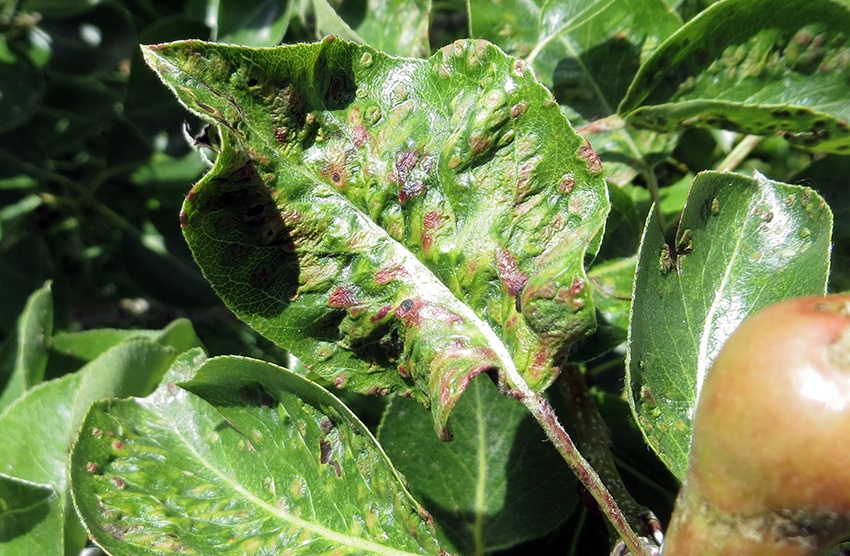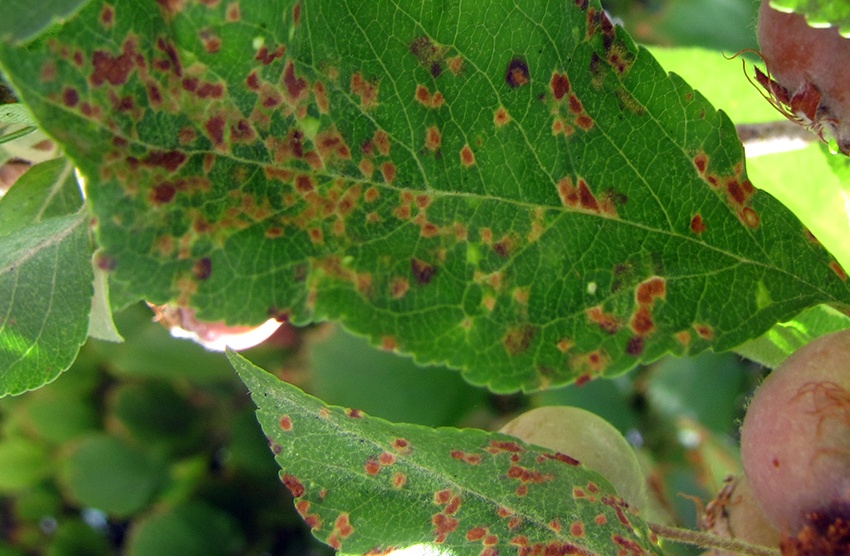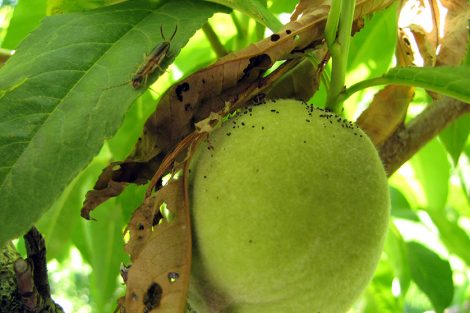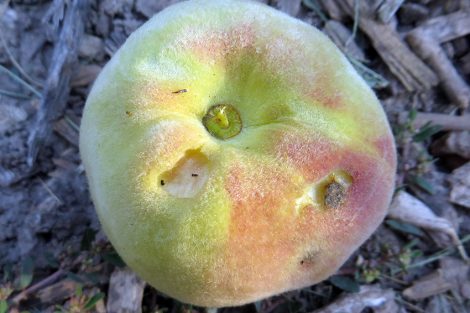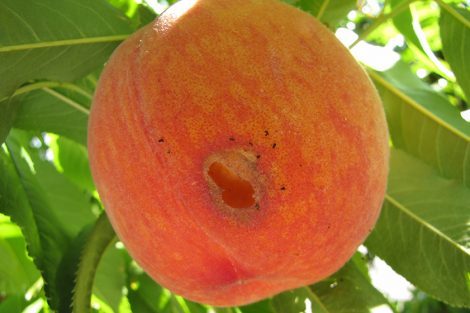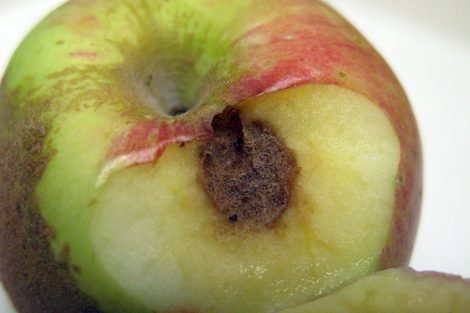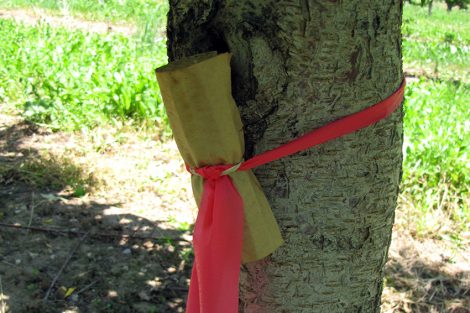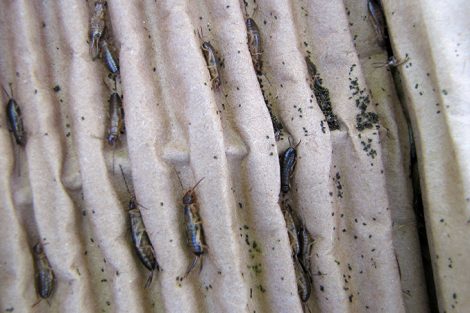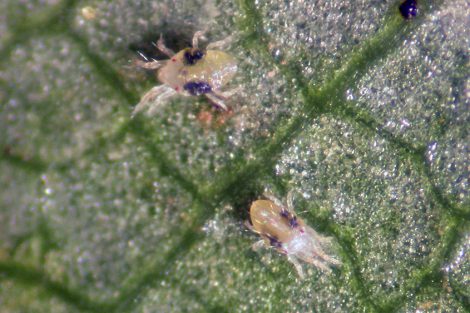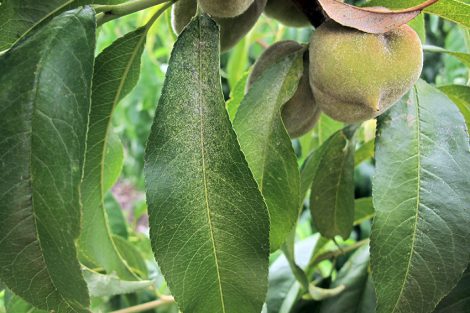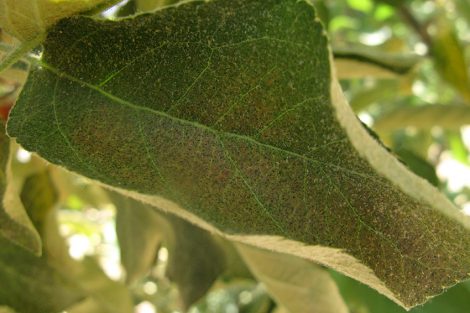In this Issue
- Apple, Pear: codling moth updated dates, woolly apple aphid, blister mites
- Peach, Apricot: peach twig borer updated dates, greater peachtree borer
- All Fruits: earwigs, spider mites
APPLE, PEAR
Codling Moth
View a pdf of the spray timing table. Be sure to read the instructions at the top of the page, for how to read the table.

Codling moth in most sites in northern Utah are starting the second generation of egg hatch. To prevent resistance to insecticides, we recommend switching to a different chemical class for the second generation treatment. Note that the table includes a date range when “rapid egg hatch” occurs, and if you can tolerate higher injury or have a low population, you can protect the fruit just during this time period.
Otherwise, if you are not using mating disruption, provide continual protect of apples and pears from now until harvest or September 15, whichever is earliest.
Assess Damage from First Generation
Now is a great time to determine the results of your codling moth control so far.
Commercial orchards should examine 5-10% of the fruit, and residential growers should check as many fruits as possible. Do not neglect fruit at the top of the tree where sprays may not have reached, or where residual insecticide may have broken down more quickly due to higher UV exposure.
A successful codling moth entry will show frass (sawdust-like excrement) pushed out of the apple at the entry hole. Most first generation entries are through the calyx end because, while fruit is still firm, it is easier for the larvae to enter at that location. Although not as common, side entries can also be found now, usually where two fruit touch or where leaves touch the fruit.
A codling moth sting is a small brown blemish on the fruit where the codling moth larva did not successfully enter the fruit, either because it was killed, or it moved to a different spot. Stings from first generation are usually not as noticeable at harvest.
If you cut into the fruit to look for the larva inside, you can sometimes tell when control failed. If larvae are large or there is no larva in the fruit, then the entry occurred approximately near the beginning of egg-hatch.
Medium-sized larvae (1/3-2/3-inch long) indicate that entry occurred at the early to mid egg-hatch period (early June), and if the larvae are small, they entered in late June.
If you are finding a lot of damage, evaluate your management program to improve control for the second generation. Consider the material used, the spraying method, and the length of time between treatments.
Woolly Apple Aphid

We mentioned woolly apple aphid in the May 15 advisory, and it is worth mentioning again. Colonies have been increasing in size over the last month and are very visible now. They are difficult to manage at this time of year due to the sticky, cottony wax material that covers each aphid.
This aphid not only feeds in the canopy, but a majority of the population on a single tree is feeding on the roots. As they suck sap contents from twigs, bark, and roots, galls form that may hinder tree vigor.
Treatment
- Residential growers can use insecticidal soap+1% oil (organic), or mix 1% oil with Spectracide Triazicide or GardenTech Sevin, aimed directly at the colonies.
- Options for commercial growers: click here.
Blister Mites
Blister mites are primarily a backyard orchard pest, and damage is very visible now. The blisters resemble fungal leaf spots, but instead contain hundreds of microscopic mites. The mites feed inside the blisters all summer. On apple leaves, the blisters age to brown, and on pear leaves, they age to a dark brown/black.
After harvest, the mites leave the blisters and migrate to leaf buds to spend the winter.
Note that there is nothing to do for treatment at this time of year, but an application after harvest and close to leaf drop will help. Materials include carbaryl, sulfur, or oil.
PEACH/NECTARINE, APRICOT, PLUM, WALNUT
Peach Twig Borer
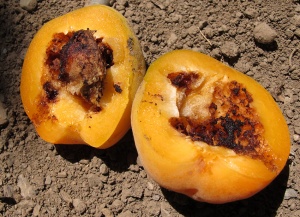
View a pdf of the spray timing table. Be sure to read the instructions at the top of the page, for how to read the table.
Second generation egg hatch will begin in mid-July at most locations. In high-population areas, two cover sprays may be required. In low population areas, only one application is needed.
Pay attention to apricots, which ripen earlier. At this time of year, peach twig borer larvae will be entering fruit as they ripen.
Greater Peachtree Borer
Continue to protect the lower 12-18 inches of trunk for peach/nectarine, apricot, and plum through September.
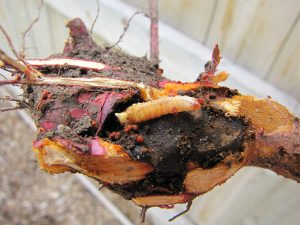
Make sure the spray covers the entire surface area, particularly close to ground level, and any exposed roots.
Young trees can be killed when trunks are girdled by feeding; older trees are weakened and become susceptible to attack by pathogens and bark beetles.
Treatment
Materials for home growers include:
- Hi Yield Permethrin (apply once/month)
- Spectracide Triazicide (apply every 3 weeks)
- organic options are spinosad and pyrethrum (apply every 7 to 10 days)
Other ways to prevent attack are:
- Remove all weeds, grass, and excess soil from around the base of the tree. Heat and dryness reduce the survival of eggs and larvae.
- Avoid mechanical and rodent-caused injuries to trunks.
- Keep trees healthy with optimal nutrition and irrigation.
ALL FRUITS
Earwigs
Earwig populations are high this season in many locations. They do not like dry conditions, so they are concentrated in areas that are irrigated and have moist, cool places to hide during the day.
Earwigs can cause fruit damage by feeding directly on the fruit skin and flesh, or entering fruit such as peach and feeding near the pit. At this time of year, while the fruit is still hard, they are feeding on leaves or other insects. They feed mostly at night, leaving behind trails of black frass.
The timing for spraying against earwigs in commercial orchards should coincide with the greatest abundance of nymphs and adults rather than fruit ripeness or injury level. For Utah County commercial peach orchards, this timing is between July 21 and 24.
Treatment
To manage earwigs, use a variety of options:
For small farm or backyard situations, regular trapping is a highly effective tool. Traps made with smelly oil work particularly well. A small container (plastic or tuna can-type) would be filled with about a half inch of fish oil, bacon grease, or a mix of soy sauce plus cooking oil. Place the container on the ground in hot spots and clean them out and refill daily until very few are captured. Other trap options include rolled-up news-paper; rolled up corrugated cardboard; bamboo sticks; or short pieces of hose. These types of traps can be thrown out and replaced each morning.
Earwigs hide in dark, moist environments. Where possible, keep mulch away from trees and remove weedy growth or groundcovers from the base of trees. Remove tree suckers or any limbs touching the ground. Remove loose bark on fruit trees where earwigs can hide.
Pick fruit as soon as it starts to ripen.
Some insecticides are effective against earwigs. Spinosad kills earwigs after they feed on the residual material. It can be used either as a spray (Success, Entrust) or bait sprinkled at the base of trees (Sluggo Plus). (In this method, the bait must be used before the earwigs enter the tree. Otherwise, sprinkle bait in tree crotches.) Carbaryl can also be used, applied to the tree trunk and scaffold limbs, but again, it must be applied as soon as earwigs are starting to enter the tree.
Spider Mites
So far, spider mite activity has been low on apples, peaches, and cherries in northern Utah. With the onset of the hottest days of the summer, their populations will start to spike in the next few weeks.
Check for mites by examining the leaves on the lowest branches first. (Mites overwinter in groundcover and migrate up the tree in hot, dry weather.) Look for leaves that are stippled, and turn them over. Using a hand lens, look for the slow-moving mites.
Before making a decision on whether to treat, also look for predatory mites within the pest mite population. These are fast-moving mites, about the same size, that can prevent spider mite densities from exceeding economic thresholds. If predators are present, then a treatment may not be necessary.
Treatment
A 0.5-1% application of horticultural oil is very effective on mites, especially when populations are low, and when the spray coverage is good enough to cover the undersides of the leaves. Repeat on a regular basis or mix the oil with other sprays.
Spider mite options for commercial growers. (Select the crop, and then select “fruit present” stage.)

